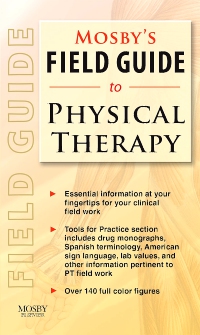Mosby's Field Guide to Physical Therapy - Elsevier eBook on VitalSource, 1st Edition
by Mosby
Elsevier eBook on VitalSource
ISBN:
9780323168472
Copyright:
2010
Publication Date:
05-27-2009
Page Count:
352
Imprint:
Mosby
List Price:
$40.99
Or $0.00 with a valid access code
Ideal for clinical settings, this unique, handheld reference provides the most vital details of assessment diagnosis and treatment in a portable, lay-flat format. The convenient organization with color-coded sections and information broken down into charts, tables, and lists makes it easy to find information quickly. With content compiled, created and reviewed by experts in PT practice and education, you’ll have all of the information you depend on for academic and clinical success in one convenient reference!
-
- Coverage of preferred practice pattern key areas - including musculoskeletal, neuromuscular, cardiovascular and pulmonary, and integumentary - prepare you for situations you’ll encounter in practice.
- Charts, tables, lists, and figures offer easy access to critical information, perfect for fast access in the field.
- Content on adult, pediatric and geriatric populations prepare you to provide the best care for each patient.
- Drug monographs include essential information on drugs that may affect physical therapy intervention.
- Tools for Practice section features important tools for clinical use including content on vital signs, lab values, common ICD-9 codes, American Sign Language, Spanish terminology, and drug monographs.
- A vibrant, full-color, user-friendly design with over 130 illustrations and color-coded sections makes it easy to find and understand information.
- Convenient, take-along format lays flat for easy reference in the busy clinical setting.
-
SECTION ONE: ANATOMY
Anatomy Atlas
Bones
Muscles
Organs and Other Anatomical Features
Muscle Origin, Insertion, and Innervation
Anatomical Directional Terms
Cranial Nerve Function
SECTION TWO: EXAMINATION
Examination/Evaluation Sequence
History and Review of Systems
Physical Exam
Sample Upper Quarter Examination Sequence
Sample Lower Quarter Examination Sequence
Tests and Measures
Tests and Measures Used in the Physical Therapy Examination
Pediatric Physical Therapy Assessments
Sample List of Examination Tools
Example of an Assessment Form
Posture Assessment
Anatomical position.
Faulty postures: Kyphosis-lordosis, swayback, and flatback compared with ideal alignment.
Joint Range of Motion and Muscle Length Testing
Procedures for Measuring Joint Range of Motion and Muscle Length
Suggested Values for Normal ROM for Joints of the Upper and Lower Extremity in Adults Based on Analysis of Existing Data
Traditionally Quoted Values for Normal ROM for Joints of the Upper and Lower Extremity in Adults
Traditionally Quoted Values for Normal ROM of the Thoracic and Lumbar Spine in Adults
Suggested Values for Normal ROM of the Thoracic and Lumbar Spine in Adults
Suggested Values for Normal ROM of Cervical Spine in Adults
Muscle Test Grades
Example of a Pain Assessment Tool
Three Standard Spasticity Scale
Ashworth Scale
Modified Ashworth Scale
Spasm Frequency Score
Key muscle groups
Tests
Shoulder
Adson’s Test
Apprehension Test of the Shoulder (Crank Test)
Impingement Test
Supraspinatus Isolation
Chest Expansion Test
Knee
Anterior drawer test
Apley Test
Ely’s Test
Lachman Test
McMurry’s Test
Posterior Drawer Test
Slocum test
Hip/Pelvis
Laguere’s Test:
Patrick’s Test (FABER or figure-four test)
Slump Test
Straight Leg Raising
Trendelenburg Test
Spine
Back Movements
Standing Flexion Test
Sacral Fixation Test (also called Gillet's Test, Marching Test, or Stork Test)
Landmarks Palpated for Symmetry as Part of the Sacroiliac Examination.
Prone Instability Test
Neck
Position testing of the cervical spine
Supine Vertebral Artery Test
Spurling's Test
Hand/Wrist/Thumb
Finkelstein's Test to detect tenosynovitis of the thumb or De Quervain's syndrome
Phalen’s Test
Nerves
Tinel’s Test
Plantar or Babinski Reflex
Special Neurological Tests
Common Imaging Techniques
Guidelines for Referral
SECTION THREE: EVALUATION, DIAGNOSIS AND PROGNOSIS
Evaluation
Evaluating Cranial Nerves
Diagnosis/Prognosis
Spinal Disorder Diagnoses
Connective tissue dysfunction Diagnoses
Examples of Fractures
Polyneuropathies
Spinal Cord Injuries
Examples of Non progressive spinal disorders
Key Terms Important to the Assessment of Spinal Cord Injury
American Spinal Injury Association (ASIA) Standard Neurological Classification of Spinal Cord Injury.
ASIA Impairment Scale
Skin Breakdown Prevention and Pressure Relief
Lymphatic system disorders Diagnoses7
Indications for Joint Mobilization
Skin Conditions
The ABCDs of Skin Cancer
Skin, Hand and Nails Infections
Common Causes of Skin and Nail Bed Changes
Hand and Nail bed Assessment
Common Variations in Nail Shape
Pressure ulcers in NPUAP Stage.A, Stage I;B, stage II;C, stage III;D, stage IV
Burn Injury Classification
Rule of Nines provides a quick method for estimating the extent of a burn injury.
Neurologic Evaluation
Signs and Symptoms of Mixed Peripheral Nerve (Lower Motor Neuron) Lesions
Summary of Upper Motor Neurons
Causes of Balance Problems
Normal Eye Movements
Consequences of various visual impairments
Cardiopulmonary Evaluation
Dyspnea/Angina Scale
Pitting Edema Scale
Early warning signs of a heart attack
SECTION FOUR: INTERVENTION
Manipulation Techniques
Definitions of Manual Therapy Terminology
Sample Manipulation Technique
Lumbopelvic (Sacroiliac Region) Manipulation
Physical Agents
Categories of Physical Agents
Physical Agents for Promoting Tissue Healing
Physical Agents for the Treatment of Pain
Physical Agents for the Treatment of Motion Restrictions
Physical Agents for the Treatment of Tone Abnormalities
Cardiopulmonary Drainage Positions
Considerations when Selecting an Airway Clearance Technique
Fall Prevention for Individuals with Increased Fall Risk
Wheelchairs
Advantages, Disadvantages and Possible Applications of Various Wheeled Mobility Technologies
Types of Manual Wheelchairs
Types of Powered Wheelchairs
Manual Mobility vs Powered Mobility Considerations
Physical Assessment in Wheelchair Selection
Parts of a Manual Wheelchair
Seating Systems
Various Types of Seating Fabrication Materials
Major Wheelchair Manufacturers
Assistive Devices
Examples of Assistive Devices for Activities of Daily Living
Home Exercise Examples
Suggested Postsurgical Home Maintenance after Total Shoulder Arthroplasty
Suggested Postsurgical Home Maintenance after Anterior Cruciate Ligament Reconstruction
Phases of Rehabilitation
Sample of the Phases for Carpal Tunnel Release Postsurgical Rehabilitation
Sample form to Track M
-
Mosby



 as described in our
as described in our 